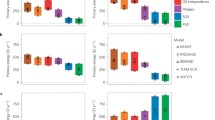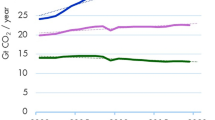Abstract
In this paper, we present results of simulation experiments with the TIME-model on the issue of mitigation strategies with regard to greenhouse gases. The TIME-model is an integrated system dynamics world energy model that takes into account the fact that the system has an inbuilt inertia and endogenous learning-by-doing dynamics, besides the more common elements of price-induced demand response and fuel substitution. First, we present four scenarios to highlight the importance of assumptions on innovations in energy technology in assessing the extent to which CO2 emissions have to be reduced. The inertia of the energy system seems to make a rise of CO2 emissions in the short term almost unavoidable. It is concluded that for the population and economic growth assumptions of the IPCC IS92a scenario, only a combination of supply- and demand-side oriented technological innovations in combination with policy measures can bring the target of CO2-concentration stabilization at 550 ppmv by the year 2100 within reach. This will probably be associated with a temporary increase in the overall energy expenditures in the world economy. Postponing the policy measures will be more disadvantageous, and less innovation in energy technology will happen.
Similar content being viewed by others
References
AGGG: 1990, ‘Targets and Indicators of Climate Change’, Rijsberman and Swart (eds.), Report of Working Group II of the Advisory Group on Greenhouse Gases (AGGG), Stockholm Environmental Institute, Stockholm, Sweden.
Alcamo, J. and Kreileman, E.: 1996, ‘Emission Scenarios and Global Climate Protection’, Global Environ. Change 6, 305-334.
Alcamo, J., Bouwman, A., Edmonds, J., Grübler, A., Morita, T., and Sugandhy, A.: 1995, ‘An Evaluation of the IPCC IS92 Emission Scenarios’, in IPCC (Intergovernmental Panel on Climate Change), Climate Change 1994, Cambridge University Press, Cambridge, U.K., Chapter 6.
Arrow, K. J., Cline, W. R., Maler, K. G., Monasinghe, M., Squitieri, R., and Stiglitz, J. E.: 1996, ‘Intertemporal Equity, Discounting, and Economic Efficiency’, in IPCC (Intergovernmental Panel on Climate Change), Climate Change 1995: Economic and Social Dimensions of Climate Change, Cambridge University Press, Cambridge, U.K., pp. 125-144.
Azar, C. and Rodhe, H.: 1997, ‘Targets for Stabilization of Atmospheric CO2’, Science 276, 1818-1819.
Berk, M. M. and Janssen, M. A.: 1997, ‘The Interactive Scenario Scanner: A Tool to Support the Dialogue between Science and Policy on Scenario Development’, RIVM Report No. 481508005, Bilthoven, the Netherlands.
Bollen, J. C., Toet, A. M. C, de Vries, H. J. M., and van den Wijngaart, R. A.: 1995, ‘Modelling Regional Energy Use for Evaluating Global Climate Scenarios’, RIVM Report No. 481507010, Bilthoven, the Netherlands.
Chakravorty, U., Roumasset, J., and Tse, K.: 1997, ‘Endogenous Substitution among Energy Resources and Global Warming’, J. Polit. Econ. 105, 1201-1234.
Cline, W. R.: 1992, The Economics of Global Warming, Institute for International Economics, Washington, U.S.A.
Davidson, P.: 1988, A Dynamic Petroleum Life-Cycle Model for the United States 1870-2050, MIT Sloan School of Management, Cambridge, MA.
Den Elzen, M. G. J., Beusen, A. H.W., and Rotmans, J.: 1997, ‘An Integrated Modeling Approach to Global Carbon and Nitrogen Cycles: Balancing their Budgets’, Global Biogeochem. Cycles 11, 191-215.
De Vries, H. J. M. and Van Den Wijngaart, R.: 1995, ‘The Targets/IMage Energy Model (TIME)’, GLOBO Report Series No. 16, RIVM, Bilthoven, the Netherlands.
De Vries, H. J. M. and Janssen, M. A.: 1996, ‘Global Energy Futures: An Integrated Perspective with the TIME Model’, GLOBO Report Series No. 18, RIVM, Bilthoven, the Netherlands.
De Vries, H. J. M., Bollen, J. C., Den Elzen, M. G. J., Gielen, A., Janssen, M. A., Kreileman, G. J. J., and Olivier, J. G. J.: 1998, ‘IMAGE-Based Scenarios of Greenhouse-Gas Emissions for the Special Report on Emissions Scenarios (SRES)’, GLOBO Report Series No. 20, RIVM, Bilthoven, the Netherlands.
De Vries, H. J. M., Janssen, M. A., and Beusen, A.: 1999, ‘Perspectives on Global Energy Futures-Simulations with the TIME Model’, Energy Pol. 27, 477-494.
Grubb, M.: 1997, ‘Technologies, Energy Systems, and the Timing of CO2 Emissions Abatement: An Overview of Economic Issues’, Energy Pol. 25, 159-172.
Janssen, M. A.: 1998, Modelling Global Change: The Art of Integrated Assessment Modelling, Edward Elgar Publishing, Cheltenham U.K./Northampton, MA, U.S.A.
Kassler: 1995, ‘Energy for Development’, Shell Selected Paper, Shell.
Lashof, D. A. and Ahuja, D. R.: 1990, ‘Relative Global Warming Potentials of Greenhouse Effect Emissions’, Nature 344, 529-531.
Messner, S.: 1997, ‘Endogenized Technological Learning in an Energy Systems Model’, J. Evol. Econ. 7, 291-313.
Naill, R.: 1977, Managing the Energy Transition-A Systems Dynamics Search for Alternatives to Oil and Gas, Ballinger, Cambridge, MA.
Nordhaus, W. D.: 1994, Managing the Global Commons: The Economics of Climate Change, MIT Press, Cambridge, MA, U.S.A.
Repetto, R. and Austin, D.: 1997, The Costs of Climate Protection: A Guide for the Perplexed, World Resource Institute, Washington, D.C., U.S.A.
Rotmans, J. and De Vries, H. J. M. (eds.): 1997, Perspectives on Global Change: The TARGETS Approach, Cambridge University Press, Cambridge, U.K.
Schneider, S. H. and Goulder, L. H.: 1997, ‘Achieving Low-Cost Emissions Targets’, Nature 389, 13-14.
Sterman, J. D.: 1981, ‘The Energy Transition and the Economy: A System Dynamics Approach' (2 Vols.), MIT Alfred P. Sloan School of Management.
United Nations (UN): 1992, ‘Framework Convention on Climate Change’, United Nations, New York.
Wigley, T. M. L., Richels, R., and Edmonds, J. A.: 1996, ‘Economic and Environmental Choices in the Stabilization of Atmospheric CO2 Concentrations’, Nature 379, 240-243.
Williams, R. H.: 1995, Variants of a Low CO 2 -Emitting Energy Supply System (Less) for the World, PNL-10851, Pacific Northwest Laboratories, Richland, WA, U.S.A.
Author information
Authors and Affiliations
Rights and permissions
About this article
Cite this article
Janssen, M.A., de Vries, B. Climate Change Policy Targets and the Role of Technological Change. Climatic Change 46, 1–28 (2000). https://doi.org/10.1023/A:1005661220604
Published:
Issue Date:
DOI: https://doi.org/10.1023/A:1005661220604




